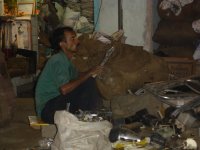The Caste System
The Caste system is strong. That’s probably an obvious statement considering how long it’s existed here but it’s still a surprise to me. For some reason, I thought that because I was going to work on for a social organization, they would’ve found a way around the caste system. Quite the contrary, it’s highly dependent upon it. There are different caste employees for each task: cleaning the offices, cooking the food, working in the office, managing projects, etc. Each individual stays strictly within the boundaries of that tasks associated with that caste. For example, those who conduct tasks at the table level (cooking, etc.) would never be found cleaning the floor.
Caste and language are strongly related. Those with more education here, speak English and those with higher caste have greater access to employment and jobs. The only benefit of British rule that I have heard of is that before the British came, lower castes had no access to education whatsoever. Now they a little bit of access. Members of service castes usually speak little or no English. Merchants usually know enough language to lure in customers at the market (“Hello, madame. Hello, madame. Beautiful stoles and saris here. Hello madame.”) They know bargaining language (“fixed price”) and numbers to tell you the price of their goods.
Currently, there are a number of caste-related issues in the media. One is similar to affirmative action, in which there is a debate over whether their version of affirmative action should apply to the “creamy layer” of scheduled castes and tribes. Scheduled castes, tribes, and "other backward castes" are the service workers. They compose the majority of the population (>75%) and are the lowest rung of the four categories, below Brahmins (priests and intellectuals), warriors, and merchants.

As the name implies, the “creamy layer” are those service workers who have experienced some amount of success relative to their social position-- financial & job secuirty. The debate for it is whether to include the creamy layer in the reservation system of who gets a spot in schools, government jobs, etc. If they take away the creamy layer reservation system, it means that if your father had access to the reservation system, you won't. However, the system has flaws that go beyond the creamy layer debate. No matter how many reservations are made, until the larger issue of the caste system is addressed, the poverty in
A major class/caste issue is discrimination against the Dalits, an indigenous group that composes ~14% of the population falls into scheduled tribe category (lower than any castes). They are discriminated against in villages in a range of ways—from not being able to take water from the village well, to not being able to own land or businesses, to not being able to ride a horse to their wedding ceremony, as is the tradition. People from higher castes refuse to drink out of a glass from a Dalit household. This is still true even for people who have been trained in social work! Thousands of Dalits have converted to Buddhism for the reason that Buddhism does not recognize castes and this is one way out of their birthright.
What boggles my mind is how the caste system preserves itself. Take a village I recently visited a couple hours outside of
Then there’s a whole part of the population outside the Hindu caste system in
Caste systems can be found among different religions, ethnicities, and countries around the world. For a more complete description of the caste systems, see
http://en.wikipedia.org/wiki/Caste#Caste_system_among_Indian_Muslims
No comments:
Post a Comment